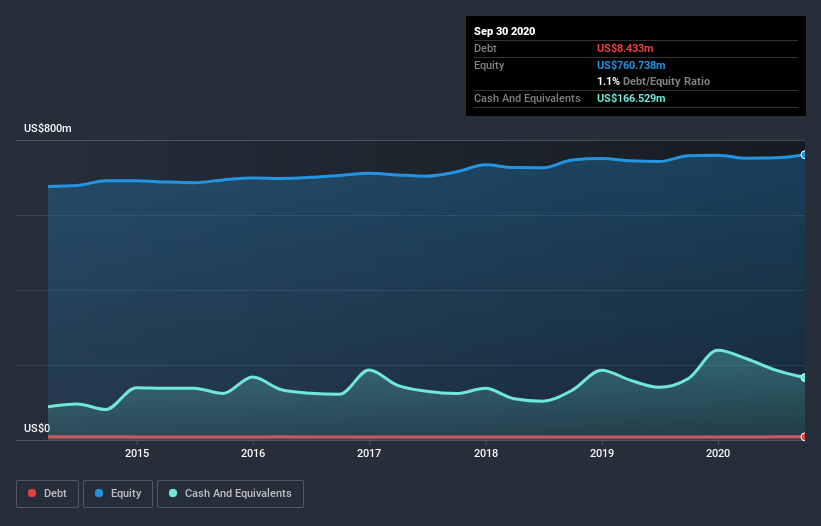- United States
- /
- Food
- /
- NYSE:TR
These 4 Measures Indicate That Tootsie Roll Industries (NYSE:TR) Is Using Debt Reasonably Well

Howard Marks put it nicely when he said that, rather than worrying about share price volatility, 'The possibility of permanent loss is the risk I worry about... and every practical investor I know worries about.' It's only natural to consider a company's balance sheet when you examine how risky it is, since debt is often involved when a business collapses. We note that Tootsie Roll Industries, Inc. (NYSE:TR) does have debt on its balance sheet. But should shareholders be worried about its use of debt?
Why Does Debt Bring Risk?
Debt is a tool to help businesses grow, but if a business is incapable of paying off its lenders, then it exists at their mercy. Ultimately, if the company can't fulfill its legal obligations to repay debt, shareholders could walk away with nothing. However, a more usual (but still expensive) situation is where a company must dilute shareholders at a cheap share price simply to get debt under control. Of course, plenty of companies use debt to fund growth, without any negative consequences. The first step when considering a company's debt levels is to consider its cash and debt together.
View our latest analysis for Tootsie Roll Industries
What Is Tootsie Roll Industries's Debt?
As you can see below, Tootsie Roll Industries had US$8.43m of debt, at September 2020, which is about the same as the year before. You can click the chart for greater detail. However, it does have US$166.5m in cash offsetting this, leading to net cash of US$158.1m.

How Healthy Is Tootsie Roll Industries' Balance Sheet?
The latest balance sheet data shows that Tootsie Roll Industries had liabilities of US$78.1m due within a year, and liabilities of US$143.2m falling due after that. On the other hand, it had cash of US$166.5m and US$70.0m worth of receivables due within a year. So it can boast US$15.2m more liquid assets than total liabilities.
This state of affairs indicates that Tootsie Roll Industries' balance sheet looks quite solid, as its total liabilities are just about equal to its liquid assets. So while it's hard to imagine that the US$2.72b company is struggling for cash, we still think it's worth monitoring its balance sheet. Succinctly put, Tootsie Roll Industries boasts net cash, so it's fair to say it does not have a heavy debt load!
But the other side of the story is that Tootsie Roll Industries saw its EBIT decline by 8.1% over the last year. That sort of decline, if sustained, will obviously make debt harder to handle. There's no doubt that we learn most about debt from the balance sheet. But you can't view debt in total isolation; since Tootsie Roll Industries will need earnings to service that debt. So when considering debt, it's definitely worth looking at the earnings trend. Click here for an interactive snapshot.
Finally, a company can only pay off debt with cold hard cash, not accounting profits. While Tootsie Roll Industries has net cash on its balance sheet, it's still worth taking a look at its ability to convert earnings before interest and tax (EBIT) to free cash flow, to help us understand how quickly it is building (or eroding) that cash balance. Over the last three years, Tootsie Roll Industries recorded free cash flow worth a fulsome 83% of its EBIT, which is stronger than we'd usually expect. That puts it in a very strong position to pay down debt.
Summing up
While we empathize with investors who find debt concerning, you should keep in mind that Tootsie Roll Industries has net cash of US$158.1m, as well as more liquid assets than liabilities. And it impressed us with free cash flow of US$71m, being 83% of its EBIT. So is Tootsie Roll Industries's debt a risk? It doesn't seem so to us. The balance sheet is clearly the area to focus on when you are analysing debt. But ultimately, every company can contain risks that exist outside of the balance sheet. These risks can be hard to spot. Every company has them, and we've spotted 2 warning signs for Tootsie Roll Industries (of which 1 is significant!) you should know about.
Of course, if you're the type of investor who prefers buying stocks without the burden of debt, then don't hesitate to discover our exclusive list of net cash growth stocks, today.
If you’re looking to trade Tootsie Roll Industries, open an account with the lowest-cost* platform trusted by professionals, Interactive Brokers. Their clients from over 200 countries and territories trade stocks, options, futures, forex, bonds and funds worldwide from a single integrated account. Promoted
Valuation is complex, but we're here to simplify it.
Discover if Tootsie Roll Industries might be undervalued or overvalued with our detailed analysis, featuring fair value estimates, potential risks, dividends, insider trades, and its financial condition.
Access Free AnalysisThis article by Simply Wall St is general in nature. It does not constitute a recommendation to buy or sell any stock, and does not take account of your objectives, or your financial situation. We aim to bring you long-term focused analysis driven by fundamental data. Note that our analysis may not factor in the latest price-sensitive company announcements or qualitative material. Simply Wall St has no position in any stocks mentioned.
*Interactive Brokers Rated Lowest Cost Broker by StockBrokers.com Annual Online Review 2020
Have feedback on this article? Concerned about the content? Get in touch with us directly. Alternatively, email editorial-team (at) simplywallst.com.
About NYSE:TR
Tootsie Roll Industries
Engages in the manufacture and sale of confectionery products in the United States, Canada, Mexico, and internationally.
Flawless balance sheet with proven track record and pays a dividend.
Similar Companies
Market Insights
Community Narratives




